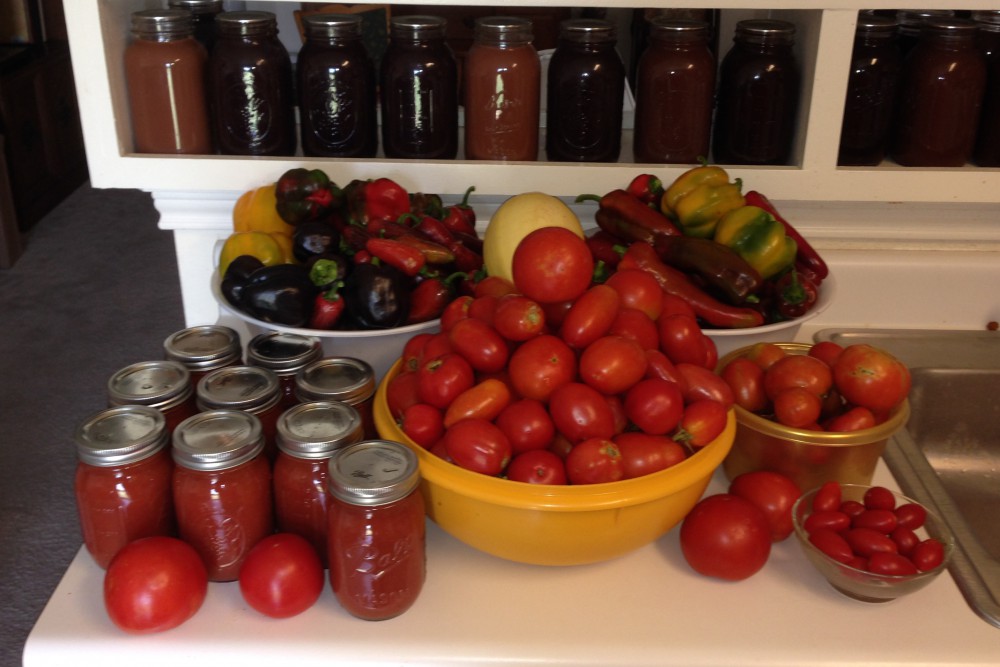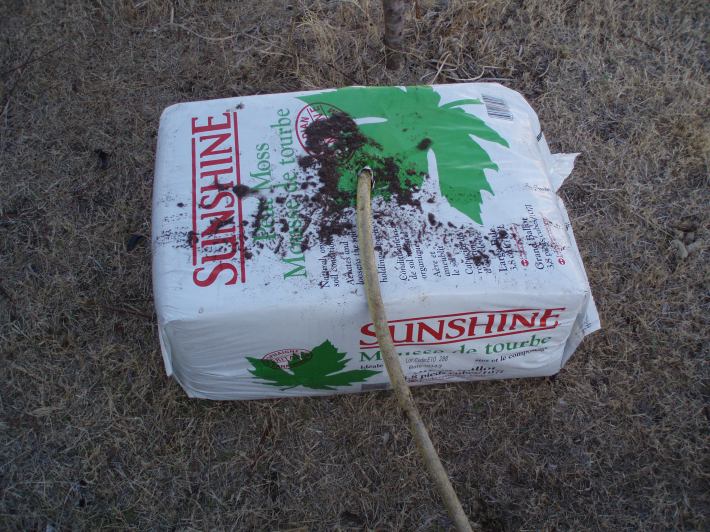The following is the formula that to use when calculating how many square feet of product you will need:
Volume = length x width x depth
Divide Volume by 324 = cubic yards
Multiply cubic yards by .27 = cubic feet needed to fill box

The following is the formula that to use when calculating how many square feet of product you will need:
Volume = length x width x depth
Divide Volume by 324 = cubic yards
Multiply cubic yards by .27 = cubic feet needed to fill box
The traditional Square Foot Gardening (SFG) mix is 1 part compost, 1 part peat-moss, 1 part vermiculite. I find that the traditional SFG mix does not do as well for Central Texas gardening and climates. The traditional SFG mix requires intensive watering in Central Texas as it does not hold moisture in the direct sun and extreme heat we have. I find I overcome this problem when I add 1 part soil to the mix. The SFG soil mix formula I highly recommend using is ¼ of each of the following components: compost, organic soil, peat moss, and vermiculite. I am partial to the Lady Bug brand of garden soil; it has won many awards and is highly rated and chock full of nutrients. I like to use Cotton Burr Compost because of the good water retention properties it has which helps the soil retain moisture. I prefer vermiculite over per-lite. NOTE: Stay away from the bargain $1-$2 bags of soil. They are full of sand. I used these in the beginning and my soil became like concrete instead of the light fluffy mix it stays when I use a higher grade organic soil.
How to Figure Soil Volume for Raised Beds:
The following is the formula that to use when calculating how many square feet of product you will need:
Volume = length x width x depth
Divide Volume by 324 = cubic yards
Multiply cubic yards by .27 = cubic feet needed to fill box
Notes on Peat Moss: Peat moss is very powdery and will blow everywhere when you try to mix it into the Square Foot Garden Soil Mix….Unless you wet it down. I do this by punching a hole in the peat moss bale and inserting the garden hose. I let the bail fill up with water and then let it sit for about an hour before I go to make my SFG soil mixture.
Notes on Cardboard and Filling the Boxes: The first raised beds I installed, I scraped the site, put my box down, filled it up, and planted my garden. To my dismay I had a profusion of weeds come up from the soil below my beds. What to do…What to do? The next growing season I took some heavy cardboard boxes (plain, not painted of covered with the plastic coating that many come with nowadays). I dug out my beds, picked the frame up, laid the cardboard boxes down and laid the frame down on top of the card board boxes, and filled my boxes up again. Walla! No more weeds (except what the birds or winds blew in which were much easier to manage). Using card board provided a barrier for the weeds reaching the sun and in two growing seasons the cardboard had biodegraded.
Fill the SFG box with the SFG soil mixture components…and this is where I have the most fun…using my hands I reach in and begin mixing the SFG soil ingredients as if I were making a big tossed salad until I have an even distribution of all the soil components through-out the mix.
Here is the finished product. The dimensions of this box is 3’x4′. From start to finish this took me 2 hours to complete going through all the steps outlined in this primer.
SOWING FROM SEEDS
PLANT STARTS
For more tidbits – http://www.naturalgardeneraustin.com/what-to-do-in-april.html
My trees are in full bloom right now and some are setting fruit. My friend asked me how I prune my trees. I gave him the following five rules that I use:
SOW SEEDS
VEGETABLES: Beans, Beets. LATE MARCH: Black-eyed Peas, Chard, Collards, Corn, Cucumber, Endive, Malabar Spinach, Mustard, Pumpkin, New Zealand Spinach, Summer Squash. HERBS: Chives, Epazote, Milk Thistle. late march: Basil. ANNUALS: Castor Bean, Cleome, Cypress Vine, Gomphrena, Gourds, Marigold, Moonflower, Morning Glory, Nicotiana, Sunflowers.
PLANT
VEGETABLES:: Chard, Corn, Cucumber, Eggplant, Endive, Malabar Spinach, Mustard, Peppers, Pumpkin, New Zealand Spinach, Summer Squash, Tomatillos (you need at least two!), Tomatoes. HERBS: Artemesia, Basil, Bergamot, Catmint, Catnip, Chives, Comfrey, Scented Geraniums, Echinacea, Feverfew, Lavender, Lemongrass, Mint, Oregano, Rosemary, Sage, Santolina, Savory, Sorrel, Thyme. ANNUALS: Cleome, Cockscomb, Coleus, Cosmos, Gomphrena, Gourds, Lion’s Tail, Marigold, Nicotiana, Pentas, Torenia, Zinnias. PERRENIALS: Blackfoot Daisy, Cigar Plant, Damianita, Esperanza, Firebush, Plumbago, Spiderwort.
FEED AND CULTIVATE
Till in winter cover crops. Allow two weeks for the cover crop to decompose in the soil before planting in that area. Spray your plants with seaweed for increased heat tolerance, winter hardiness, and pest and disease resistance. Seaweed contains naturally-occurring plant hormones, micronutrients and trace minerals that are vital to plant health, and when it’s used as a soil drench, seaweed is a great natural root stimulator and anti-stressor for plants. All plants love seaweed!
For more tidbits – http://www.naturalgardeneraustin.com/what-to-do-in-march.html
Time to start Sowing Seeds – suggested by John are (Vegetables) Beets, Carrots, Endive, Kale, Kohlrabi, Lettuce, Mustard Greens, Parsnip, Peas, Radish, Rutabaga, Spinach, Turnips, (Herbs) Chives, Cilantro, Dill, Echinacea, Parsley. This is the time to start Tomatoes and Peppers indoors.
Time to plant your starts (Vegetables) Artichokes, Asparagus, Asian Greens, Broccoli, Cabbage, Chard, Collards, Lettuce, Mustard Greens, Onion Sets, Seed Potatoes, Shallot Bulbs, Spinach, (Fruit) Blackberries, Dewberries, Grapes, Figs, Pears, Persimmon, Pomegranate, Strawberries (Herbs) Calendula, Chives, Cilantro, Dill, Echinacea, Fennel, Feverfew, Lavender, Pansies, Parsley, Oregano, Rosemary, Sage, Savory, Sorrel, Thyme.
Shear and shape hardy herbs as needed. Oregano, Rosemary, Savory, and Thyme will especially benefit from a late-winter haircut.
Prune immature fruit trees if needed. Spray Apples, Peaches, Pears and Plums with an all-natural fungicide when the buds begin to swell. If you haven’t done it yet, apply Corn Gluten natural pre-emergent weed control.
For a more detailed list of things to do including flower, ornamentals, shrubs etc, visit his website.
http://www.naturalgardeneraustin.com/what-to-do-in-February.html

Here is a tree planting primer for planting bare root trees. This is how my father taught me and I have planted hundreds of trees this way with great success. I hope this help. You can save money on the cost of trees when planting bare root trees. In Texas January and February are the perfect months to do this. Any later buy rooted trees. Happy Planting.
Here is a tree planting primer for planting bare root trees. This is how my father taught me and I have planted hundreds of trees this way with great success. I hope this help. You can save money on the cost of trees when planting bare root trees. And in Texas, this it the perfect time to do this.
Like ·
I am not about re-inventing the wheel when someone has done it much better than I. This is one of the best videos on I found on YouTube on pruning fig trees. It also explains the growth habit of fig trees. www.youtube.com/watch?v=alO4VYPPWCo
Happy Pruning!
I am posting this a little late for this year…but put this in your minds for next year:
January is the last month to safely prune your oak trees without exposing it to the oak will virus. In February the beetles that carry the oak wilt virus become active again…to minimize the risk of spreading oak wilt you need to prune between November and February. Remember to wipe your cutters with lysol wipes to avoid the spread of any other infections. For a good resource on pruning oaks to avoid oak wilt in Texas: http://texasoakwilt.org/2011/pruning-guidelines-for-prevention-of-oak-wilt-in-texas/
One of the problems that urban and suburban gardeners is lack of bee activity. I plant lemon basil at the edge of my garden and the heart of my garden and draw all kinds of bee activity in my veggie patch. And when the wind blows it smells like lemons on the air. If you are lacking bees in your garden consider planting these in and around your garden.

Ilustration by Hannah Rosengren, https://www.etsy.com/shop/HannahRosengren
Illustration by Hannah Rosengren, https://www.etsy.com/shop/HannahRosengren